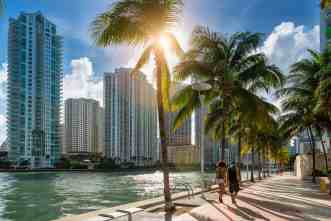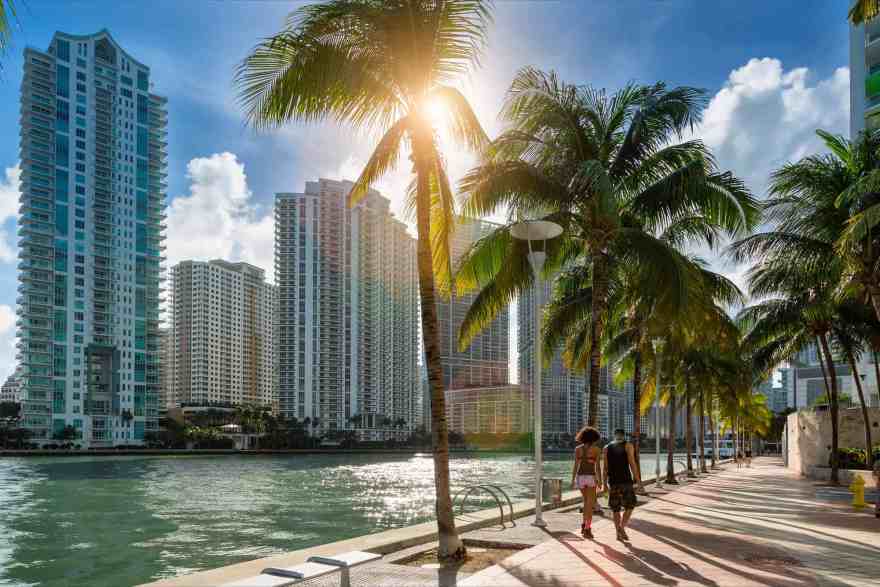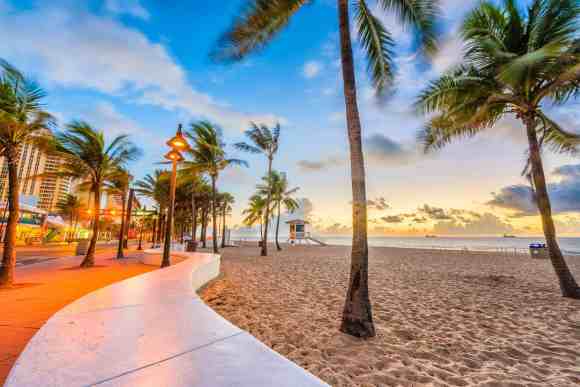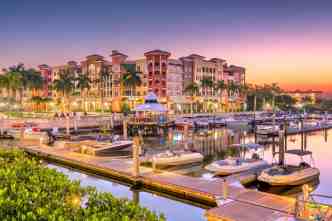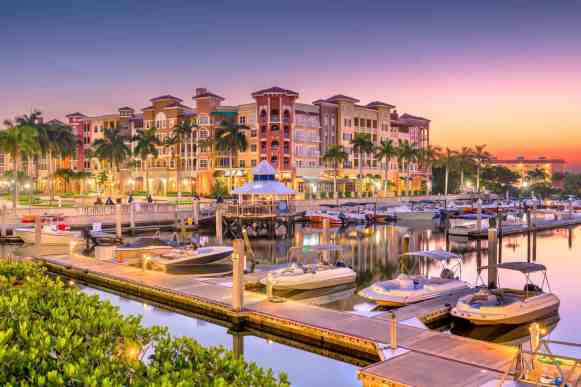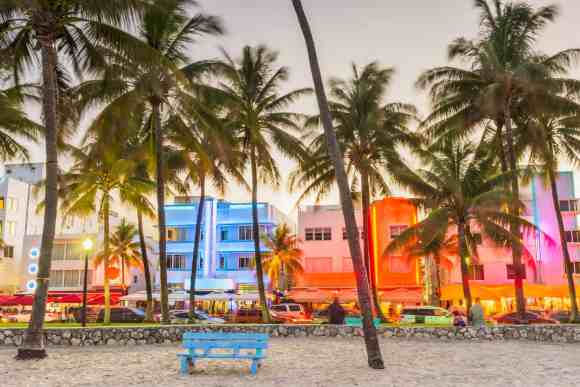Could this rich, arty, and extravagant city in the Sunshine State of Florida be the ideal destination for you to call home, or will you feel completely lost living in Miami? Read on to find out whether Miami could be your kind of city.
What makes Miami so special?
Miami is diverse. In fact, it’s one of the most diverse cities in the United States. Miami residents come from all over the world, the Caribbean, Central and South America, Canada, Puerto Rico, and further afield from Asia and Europe.
Miami was never intended for the quiet and reflective. It’s loud, arty, wealthy, opulent, and fun! To really experience the best of living in Miami, you’ll need financial confidence, an adventurous spirit, and not be too hung up on hitting a minimum of 8 hours of sleep every night.
If this sounds like you, let’s go and explore Miami…
Is Miami a good place to live?
The answer to that question really depends on who you are. Miami is the perfect place to live if you love diversity, non-conformism, and a non-stop raging nightlife.
If you’re comfortably off and can afford to pay a premium to rent or purchase a nice home in the right neighborhood, your chances of enjoying the city are much higher.
You probably shouldn’t be planning to move to Miami with a view to becoming dependent on a basic job to get by. Miami is a wealthy city, but many of the jobs in the local economy are very poorly paid.
There’s more tolerance for freedom of expression in Miami than in many other cities. You’ll see and experience things that soon feel quite normal in Miami but would probably be deemed downright crazy or at least frowned upon in other parts of the country.
Ask any Miami resident about the highlights of living in Miami, and one answer is sure to stand above the others. Miami has an electrifying nightlife scene that most cities would find hard to compete with. With endless bars and restaurants and a myriad of nightclubs that stay open until 5 am, if you like to party and you’ve got the stamina, Miami is waiting for you.
Miami has an always-on vibe with so many newcomers ready and eager to make friends and make time for each other. However, if you’re looking to build long-term, meaningful friendships, you might feel a bit disappointed – relationships and friendships can bit quite transient here.
Miami’s critics will tell you that it is a very materialistic city. A sizable proportion of the population seems to place a lot more value on material wealth and assets rather than on building long-term relationships with their neighbors.
There are a lot of hustlers inhabiting the city; Miami residents quickly learn to be cautious of anyone who over-enthusiastically jumps uninvited into a conversation, especially if they have a great idea!
Living in Miami is like dating a smoking hot, bipolar person with a maxed out credit card and anger issues.
Reddit
On the whole, living in Miami is a fun-packed adrenaline rush, especially when you’re young and wealthy. Eventually, though, you may fall out of love with the craziness and realize that your hedonistic lifestyle might not be the best choice for long-term health and sanity.
This takes us smoothly to the next question:
Is Miami a good place for singles?
Absolutely! While you are free from family commitments, enjoy Miami to the full! It’s not just about partying all the time.

Miami has a lot to offer singles: beaches, health and fitness venues, golf, boating, fishing, free diving, kayaking, sailing regattas, scuba diving, snorkeling, swimming, water skiing, windsurfing, and major league sporting events.
There’s also a romantic artery pulsing through the city. Miami has been ranked as one of the best places for dating! The city has an active dating scene, not without its own little quirks, however.
For women looking for a date, there is a fly in the ointment in that there are more ladies than gents living in Miami. It’s not over the top, the ratio is 51% to 49%, but it’s enough to tip the balance in the men’s favor and make it a bit tougher for women to find their perfect match.
Another thing is that there are more educated women than men in Miami, again making it trickier for the smarter ladies who appreciate a good measure of cerebral stimulation.
It’s worth noting that the bachelor lifestyle is celebrated here… So, yes, Miami is perfect if you are a single male who’s not looking for commitment, but maybe not so much if you are a single female looking for a serious and long-lasting relationship.
Where to live in Miami?
As a rule, young career-orientated professionals choose Miami proper, party fans tend to head toward Miami Beach, and families gravitate to the suburbs.
When choosing a neighborhood to live in, checking the crime statistics is essential. Miami has quite a mix of areas, good and bad, and often in a relatively short space; you don’t want to end up living in an unsafe area.
Areas like North Coconut Grove and The Islands are quite safe, with a crime rate of 60% of Miami’s average.
Families should consider Coral Gables, Coconut Grove, Kendall Key Biscayne, South Miami, and Pinecrest. They are also safe and very family-friendly neighborhoods.
Neigborhoods that you possibly want to avoid are Overtown, Opa-Locka, Downtown, Wynwood, and Model City.
As it goes, the lower the crime rate, the higher the price tag, and the safest spots in Miami are pretty expensive.
Coconut Grove – something for everyone
Coconut Grove is a top all-rounder where everyone can find something that works for their lifestyle. Families will enjoy schools, gyms, cinemas, shopping facilities, and historical sites.
Young professionals will appreciate great nightlife. There’s a good variety of quality restaurants and cafes, and at night the area comes alive with locals and students from nearby universities gathering for fun and entertainment.
The best benefit about living in Coconut Grove is the access you’ll enjoy to nearby beaches and bike paths and the numerous festivals and outdoor events being held here on a regular basis.
The biggest event is the three-day Coconut Grove Arts Festival, during which the neighborhood comes alive with music, food and culinary displays, live performances, art, and entertaining family areas.
Coral Gables – exclusive suburban living
Seven miles southwest of Downtown Miami, you will find Coral Gables, a city in Miami-Dade County, Florida. Home to the University of Miami, Coral Gables is one of the most sought-after neighborhoods for families.
Well regarded for its affluent character, Coral Gables is well organized, full of charm, and lush greenery. Living here, you will have access to upscale restaurants, great shopping, a theatre, an art-house cinema, museums, and world-class golf and tennis.
This is also where you can find the best suburban living environment in the whole of Miami, as several most sought-after gated communities are located in Coral Gables, such as Gables Estate, Cocoplum, Islands of Cocoplum, and Tahiti Beach.
These exclusive communities feature waterfront properties and stunning mansions, many with their own private docks, proximity to excellent private schools, world-class golf courses, and easy access to the Miami International Airport, the Port of Miami, Brickell, Downtown Miami, and the vibrant South Beach neighborhood.
Brickell – great for professionals
Brickell, the core of Miami’s financial district, is where professionals choose to live. This vibrant and booming neighborhood has seen a significant influx of newcomers and has a somewhat transient nature. Designed as a community where everything you need is within walking distance, Brickell is super convenient.
Mary Brickell Village, the heart of the area, is where you’ll discover the best shops, boutiques, restaurants, and cafes.
Brickell City Centre is the entertainment and retail hub with a 3-level, open-air shopping center, Cinemex, residential condos, and offices.
The area is an embodiment of a cosmopolitan and urban lifestyle where you can find luxury condos with spectacular views of Biscayne Bay and Downtown Miami.
Pinecrest
An urban village and upscale location, Pinecrest has earnt a reputation as one of the best places to live in Miami. Pinecrest is great for families, retirees, and professionals alike.
Needless to say, Pinecrest isn’t a cheap area to live in, but it’s a safe neighborhood with great schools and facilities. The majority of the residents are well-educated homeowners, and the local population is well-catered for in terms of services and amenities.
Like many expensive communities, Pinecrest even has its own police department to ensure good levels of security, safety, and peace of mind.
Pinecrest farmers market is one of the best in Miami. It’s packed with fresh produce and is a favorite local shopping trip.
Outdoor lovers will appreciate Pinecrest’s variety of parks and running/biking paths.
Housing prices tend to be on the high side. If you can’t stretch your budget sufficiently, you may want to consider Palmetto Bay. It’s just south and with access to the school system and some other government resources of Pinecrest.
Flagami – livable and more affordable
Flagami is a residential area south of Miami International Airport and Blue Lagoon. This diverse neighborhood is suitable for singles, retirees, and families, although it lacks some of the children’s amenities that other locations enjoy.
Here you can find a good range of townhouses, single-family homes, and condos, many of which are rental properties.
There’s no nightlife to speak of here. If you commute downtown, you will need a car and about an hour spent in traffic queues each day. Another downside is that it feels a bit overbuilt and has unkempt corners here and there.
On the positive side, Flagami is very walkable, and there are a lot of restaurants, coffee shops, and parks nearby.
There are also plenty of recreational activities throughout the neighborhood, including a golf course, a water park, and a cinema.
Retirees like Flagami for its quiet and calm atmosphere and families – for plenty of good schools around.
On the whole, Flagami is a bit of a goldilocks that balances value against the range of available amenities. If this is what you are looking for, there are a few other neighborhoods around Miami that have similar characteristics to Flagami, such as West Flagler, Little Havana, and Hialeah.
How much does it cost to live in Miami?
Miami is definitely not a good option for anyone seeking a low-cost lifestyle. It is home to the 5th richest zip code in the whole country, Miami Beach 33109, where the median home sale price in 2021 was a whopping $4,475,000.

The overall cost of living in Miami is 17% higher than the national average. And yes, it means you will pay more for day-to-day things such as utility bills, groceries, going out, and transport.
To rent a basic one-bedroom apartment, you will need to budget around $2,200, plus everyday expenses that average around £1,000 a month for a single person.
Plus, Florida, in general, has one of the highest healthcare costs in the whole country.
If you are moving to Florida from abroad, it’s worth shopping around for a good international health plan. To make sure you get the best value for money, compare international health insurance options from various providers to find the best deal.
What income do you need to live in Miami?
To have a decent lifestyle and appreciate everything Miami has to offer, you need to make at least $77,000 a year. The lifestyle that you may have in mind when you think of Miami will almost certainly need a lot more than that.
How much is the average salary in Miami?
Unlike other cities where there’s a lot of wealth, it’s not high. This is the dilemma – over 50% of jobs available in Miami pay below the national median wage. The average monthly salary in Miami, after taxes, is around $2,700, which won’t get you anywhere close to living a true Miami lifestyle.
What are the negatives of living in Miami?
Of course, like any other place on earth, the Magic City has its downsides too. Let’s talk about them.
The high cost of living means it’s hard to live well in Miami unless you have a well-paid job or your own successful business, or a robust passive income.
Top-dollar real estate contributes a lot to the high cost of living problems. Housing is not cheap in Miami, and quality rental apartments, the most in-demand dwelling, are hard to find.
Average wages in the city are pretty stagnant.
The sheer number of tourists can be overwhelming, especially in winter when snowbirds arrive in their droves to South Florida. It’s easy to believe that Canada is completely deserted during the winter months.
Public transportation is patchy. If you live outside of downtown, you need a car and have to drive just about everywhere.
On-street parking is nearly impossible most days of the week. Always account for 20 minutes minimum to find a parking spot, especially in the downtown core.
Spanish is essential. “You want to live in Miami, you must speak Spanish”, they’d tell you in perfect English.
Brush your driving skills; Miami is the epicenter of defensively-aggressive driving. Taking over a second to react to the green light at the junction? Expect a honk or two.
Humidity and heat can be hard to deal with. Oh yes, it is humid here. And hot. All the time. From June to September, it becomes muggier than usual as it’s the rainy season. So air-conditioning is essential. Make sure to budget for higher electric bills.
What are the advantages of living in Miami?
Access to the water and natural parks and resources such as the Everglades National Park and Biscayne National Park is the best thing! Being close to the ocean is amazing. You can go fishing, kayaking on the bay, walking and biking, and hanging on the beach.
It’s sunny! There is really something to be said about the impact sunshine has on your mood.
No state income tax. Yes, there is a sales tax here, and property taxes apply, but as a resident, you do not have to pay income taxes on any earnings, even pensions, Social Security, or inheritance.
Convenient access to Europe/South America/Caribbean via two large international airports and two large cruise ports within Uber distance.
Unprecedented scuba-diving experience. With turquoise, crystal-clear waters, the third-largest coral reef in the world, and over 50 sunken ships to explore, Miami is famous among scuba divers.
Festivals and concerts all year round. One of the truly unmissable events, Calle Ocho Festival, is the world’s largest Latin music festival in the country, and all 15 street blocks of Little Havana are filled with music, international food, dances, and entertainment.
The amazing food scene got even better in the post-COVID world when some top chefs moved here out of New York City and Los Angeles to find a better life.
Can you live in Miami without a car?
It depends on where in Miami you are planning to live, but the general answer is probably not! The farther away from the downtown area you are based, the more likely you need a car if you commute.
The big downside of this is the traffic, which, according to a recent study, is the fifth worst in the United States.
The best areas to live without a car are Downtown, Brickell, Coconut Grove, South Beach, etc.
So if you cannot stand traffic jams and the somewhat challenging driving style of some of Miami’s residents, public transportation, although not the best, can be a valid option.
Public transportation in Miami
The local public transportation system consists of Metrobus and Metrorail.
Metrobus serves over 95 routes from Fort Lauderdale, to Miami Beach and Key Biscayne, to Homestead, and even the Florida Keys.
Use Metrorail to travel to northwest Miami-Dade and the Jackson Memorial Hospital area, where you can connect to Broward and Palm Beach counties.
More locally, if you need to move around Downtown Miami and Brickell, or change from the Metrorail to Metrobus, use Metromover.
There’s also the Tri-Rail train system that runs north from Miami International Airport to shore-side communities such as Fort Lauderdale, Hollywood, Deerfield Beach, Boca Raton, and West Palm Beach.
There are also some cool free options, such as Trolley, which is free and can be tracked online.
Another great option is Freebee. Freebee provides free rides in Coconut Grove, Coral Gables, Key Biscayne, Downtown Miami, Brickell, Wynwood, Miami Lakes, and most of Miami Beach.
It’s a free-rides, on-demand, door-to-door service in 100% electric cars. All you need to do is to download the Ride Freebee app and request your ride. Oh, and you can tip your driver if you want to, but it’s not required.
What do I need to know before moving to Miami?
1. Miami’s residents are health obsessed
The bronzed beach-body cult is alive and well in Miami. Locals work hard to include regular exercise in their daily routine, and this somewhat vain approach resulted in Miami being rated among the Top 10 Healthiest Cities in the United States. Miami residents’ obesity rate is 23% compared to the national average of 39.6%.
2. Healthcare here is great but pricey
There’s a variety of state, county, and community health facilities, and the hospitals and doctor’s offices of Miami hold high rankings in the healthcare world. But, as we mentioned before, healthcare here is expensive.
3. The perk of waterfront apartments
To take advantage of the constant ocean breezes that cool you down and make your life so much more pleasant, make sure your apartment is right on the waterfront and preferably on a higher floor.
4. Avoid South Beach
South Beach, on the southern tip of Miami Beach, is the international beach of the city where all the tourists rush to first thing when they arrive in Miami. It’s also where various models and celebrities are based.
Because of its fame, South Beach is wildly busy and crowded and features overpriced drinks and expensive meals. Local residents actually tend to avoid it as much as possible.
5. Remember the floods
When buying your new home in Miami, check and avoid flood zones. If buying real estate close to the water, make sure your homeowner’s insurance has good coverage.
Final thoughts on living in Miami
As with any other city in the world, Miami has its ups and downs. But the unique thing that makes this city so special is its eclectic blend of urban and relaxed beach lifestyles, its global mix of residents, its fun party vibe, and its peacock character.
Miami is fast-growing and even faster changing. More high-paid industries are coming to the area, Miami’s startup scene is thriving, and financial services are establishing a good presence. This is expanding Miami’s career opportunities, making the city more attractive for young professionals.
So, if the climate is suitable for you and you can afford to enjoy all of the good bits, Miami will be a great place to call home. If it seems a bit too pricey, but you cannot give up your dream of living in the Sunshine State, check out other great places to live in Florida, including our guide on what it’s like living in Tampa.
You might find useful:
- Living In The USA – The Expats’ Guide: a detailed relocation guide covering visas and residency options, the costs, paperwork, various areas and more
- Best Places To Live In The USA For Retirees – a detailed overview of the most popular retirement locations
- Living In California – all about moving to and settling down in California
- USA Property Guide: Renting Or Buying A House In The USA – how to rent or buy a property in the States: a detailed manual for expats.

